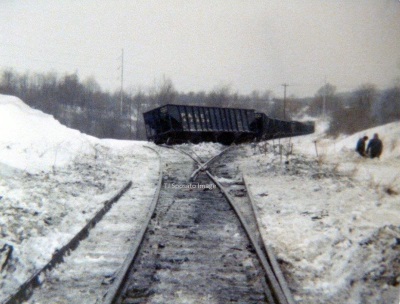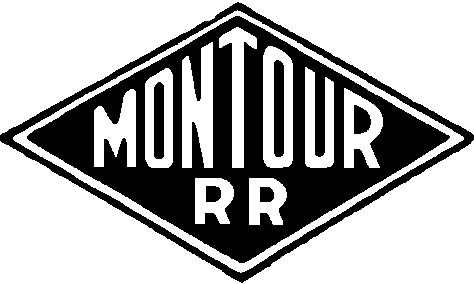Montour Railroad
Mileposts
Bridges
History
Maps
Roster
Mines
Links
Gallery
Working on the
Montour
Schaeffer Stories Sposato
Stories
Employees
Railroading
101

|
|
Tim
Sposato Stories
Libaray Junction Then and Now
 |

|
January 1977, was one of the colder and snowy months of the time.
Section Gang #2 was kept busy sweeping switches over twelve days that
month, also had worked seven derailments, some fairly major in size,
between January 1st and February 4th.
The National Weather Records states;
”The day with the deepest snow depth was January 15, with an average
snow depth of 11.8" over the course of the day. The longest stretch of
time during which there was always snow on the ground was from January
1 to February 22 (53 consecutive days)”.
In other words, cold, snow and more snow, typical Montour Railroad working weather.
We finished re-railing several loaded hoppers on the New Siding at
Library Junction on Jan. 31st, when the following day another
derailment occurred on the South Wye Switch. The Library Turn
Coal Run was shoving its train from #10 mine, out the East Wye Leg when
it encountered a broken rail near the South Wye Switch. The first
P&LE hoppers’ rear truck derailed, damaging the switch and gapping
the switch points. The second hopper picked the points open on the
switch, diverting its rear set of trucks into the West Wye Leg. The
third and following cars continued into the West Leg. The second
hopper being shoved down two tracks, twisted sideways, breaking its
coupling, thus parting the train airbrake line causing an emergency
brake application. The train stopped abruptly in the darkness of
night.
Section Gang #2 was not notified until its normal starting time at 7:30
am. The Gang gathered some tooling, materials, coffee and donuts, and
headed to the scene. Prior to the Gangs arrival, the train crew
pulled the rear portion of the train that had not derailed, back about
a quarter mile and shoved them into the Junctions siding. The engines
then returned to #10 mine, tied up on the main below the loaded yard
and Wood St. crossing. The crew was taxied back to Montour Jct.
Section Gang #2 placed its RH-2, Hi-rail truck on track at the crossing
at #10 and hi-railed up the branch to Library Jct. Upon arrival, we had
to shovel out the cross-over switches to get the RH-2 clear of the
main. Shortly thereafter a fresh train crew arrived and ran the
locomotives light back to the derailment to re-rail the cars against
the hopper that sat sideways. Once they cleared the damaged track of
hoppers the crew returned to # 10 mine. Again they tied up below
the crossing. This allowed a clear track for more hi-rail
trucks and material to be moved into place. All this sounded
simple enough here, but in reality this was over a three day period,
working dawn till dusk, before the main track was restored to
service. Though a lot of materials were hi-railed in, we also
removed rail, tie plates and joint bars from a section of the New
Siding to repair the Main track.
The February 2nd, 1977 photo of the derailment scene shows the amount
of snow we dealt with in those days. Notice the two figures on the
right. One of them is Pete Williams standing next to a dug out area in
the snow where we had built a warming fire to help with our constant
frigid condition. Hidden in the snow on the right, running
parallel to the main track and train consist was the siding. The cross
overs are behind me when I took this photo. In the distance you
can make out the rear of the train and caboose, short of fouling the
main track at the East Leg of the Wye.
The photo shows the track repair tools sticking out of the shoveled
snow piles, brooms, shovels, line bars, crow bar, ect, were standing
upright to prevent them being covered up in the snow. I took this
picture when we stopped for lunch on the second day of the derailment,
behind me the RH-2 truck was on the main track. This view shows
the amount of shoveling we had to do prior to any track repair. The
repairs was underway, but a lot more work was needed before we could
relay rails and spike them down.
Notice the wooden power line pole behind the train as well as the tall,
steel hi-tension poles following the East/West direction of the main
line. The trees were much smaller in 1977 and the terrain is
easily seen. The small cut at the derailment was clear of all foliage
and trees as well.
The modern view taken February 5th, 2017 shows how much growth has
taken place. If you look closely you can barely see the wooden
power line pole and wires. The steel towers are there, one can be seen
straight down the Trail on the right. The hillside above the
steel poles are now covered in homes and town houses.
The Montour Trail is favoring more of the roadbed location of the
siding. You can see how the Main Track would have past closer to the
tree line, now covered in cut grass. The Trail follows the West
Leg almost exactly of where the tracks once laid. On a final note, the
downed brush and tree branches on the extreme right of the picture is
approximately where the warming fire was located on that freezing
February day……40 years ago.
Tim Sposato
Gene P. Schaeffer:
As a FYI, according to the ledger I preserved on derailments, P&LE
62824 (seen here) along with 6 additional P&LE hoppers derailed
here on Jan 31, 1977, Conductor C.D Jones, Montour 74-75-78. The
derailment according to the notation was due to wide gauge. The
notation indicates the 62824 is the 2nd derailed car, so I'm guessing
the next 5 car loads of #10 coal are also derailed looking towards the
caboose?
Rich:
The montourrr.com stories about working on the right of way illustrate
what hard work was involved in keeping the RR running. I must admit,
the most difficult days for me at Mathies was laying rail. As I recall,
the rails to the working face were usually 45 pound rail. That changed
to 60 pound rail for the track leading away from the face with loaded
cars. The heaviest I remember was 85 pound rail for hauling the long
trips out to the portal. The 45 and 60 was not too hard to handle but
the 85 was a different story.
What weight was the rail for the Montour? 100 plus I would expect.
There was no automation at all for laying the rail. A few flat cars or
rail and ties would be brought up to the track end and manpower took
over. For a tall lanky kid this was backbreaking work. The gauge was
44" I believe but we used preformed metal ties with cams to lock the
rails in place. Gauging was only a concern when bending rails for turn
outs etc. The experienced crew could pound the locking cams in place
with one blow but It was a struggle for me. Everything was rusty and
dirty so a solid hit was required with the hammer to set the rail in
the tie. The hammer was like a long sledge but had a narrow head. To
make holes for the tie (fish plates?) plates or bonding sometimes a
torch was used to burn through the rail. Usually though, no torch was
handy so we had large vise-like clamps with a chamber for a .45 caliber
shell to blow a hole out. Really cool. What is the name for the type of
hammer used and the hole shooting device? Did the MRR track crews use
that method or a torch or drill?
All in all, the track gangs were THE tough guys with Popeye forearms.
|
 Montour
Railroad
Montour
Railroad 